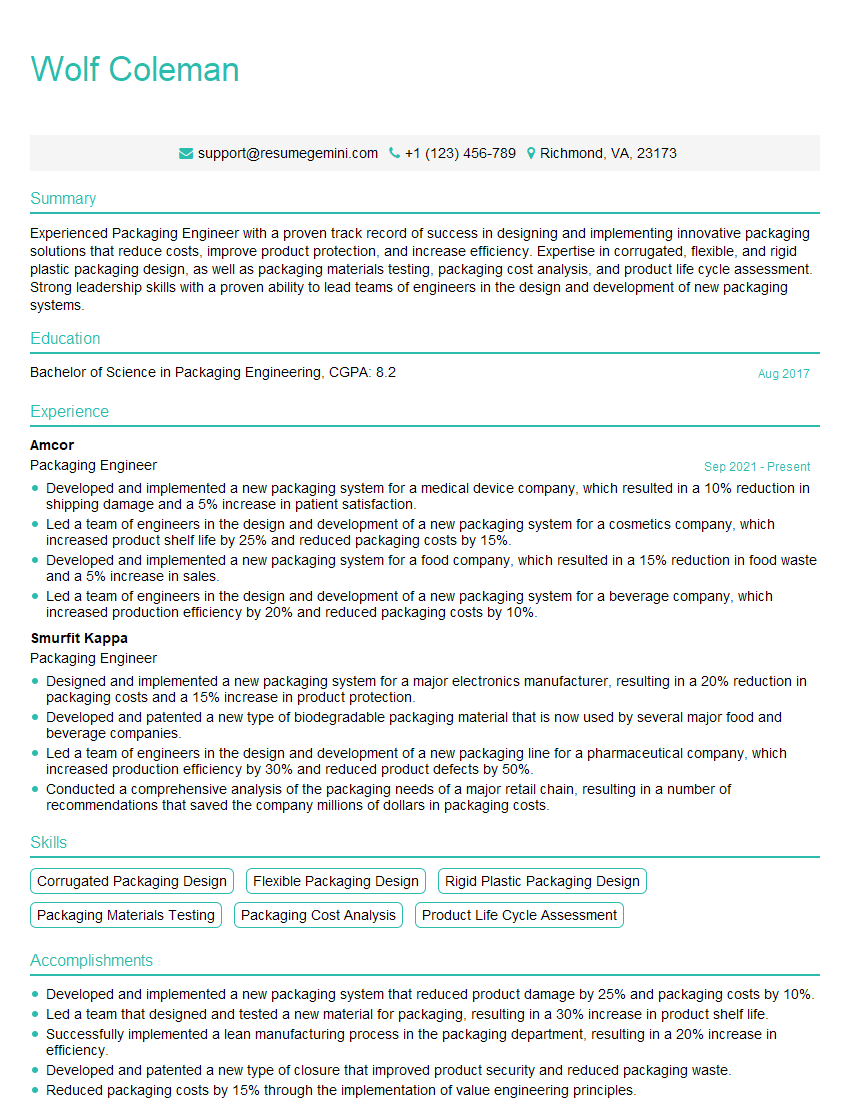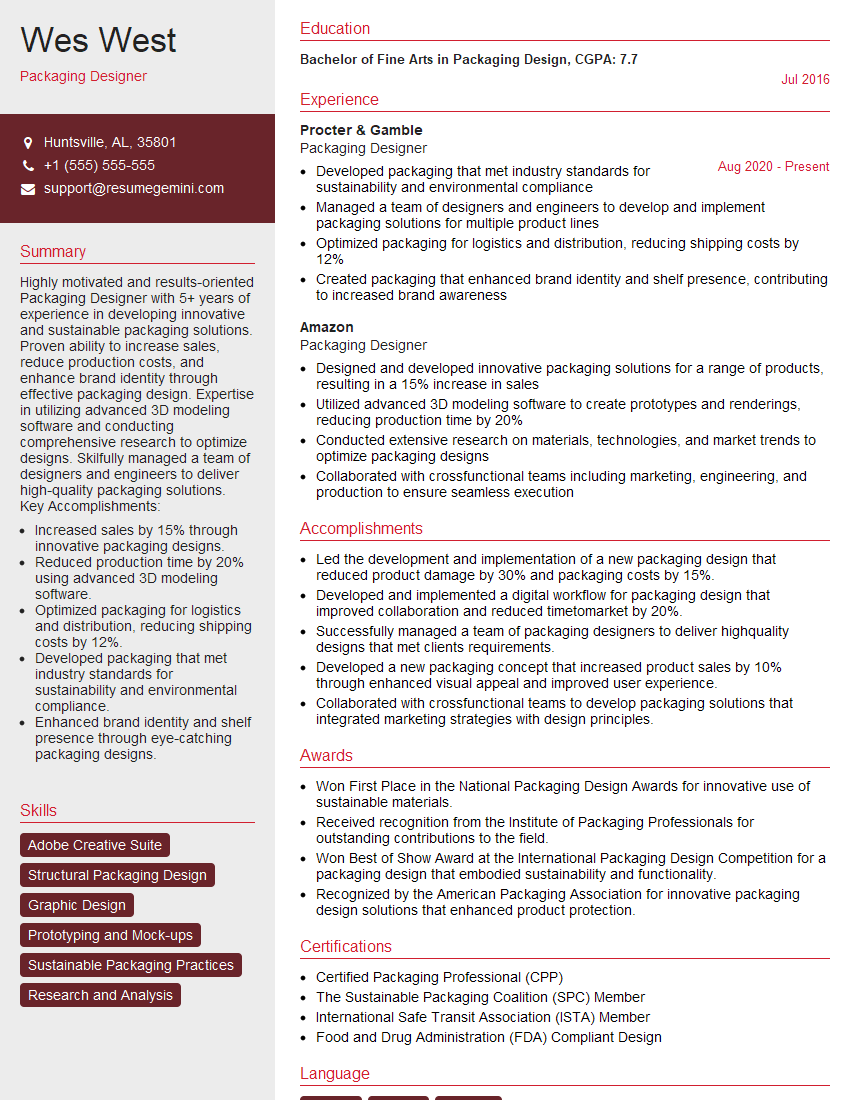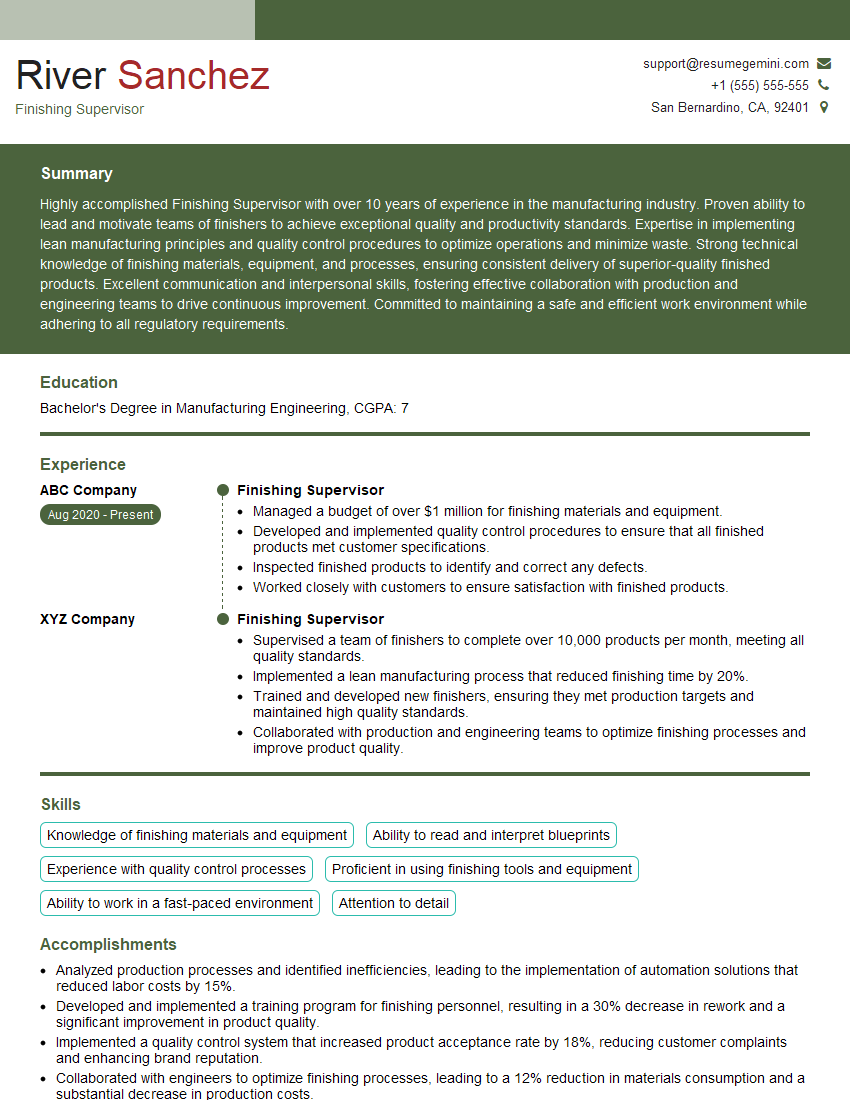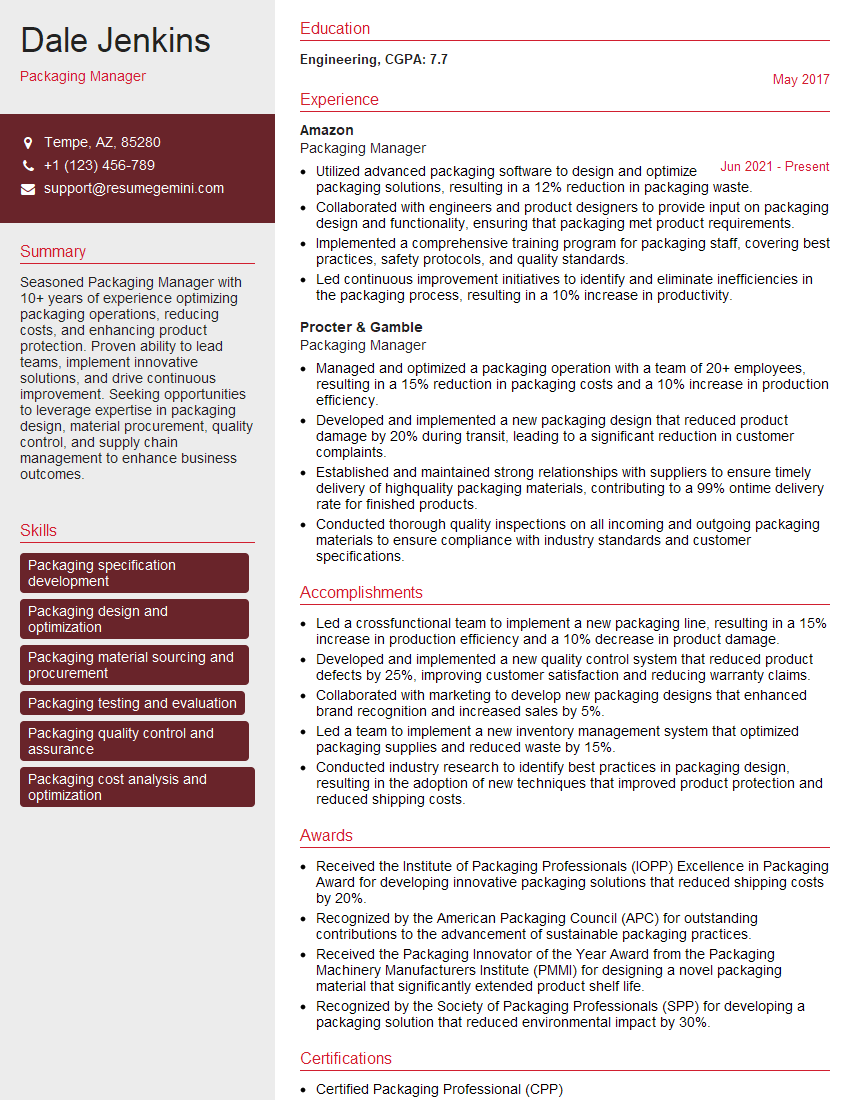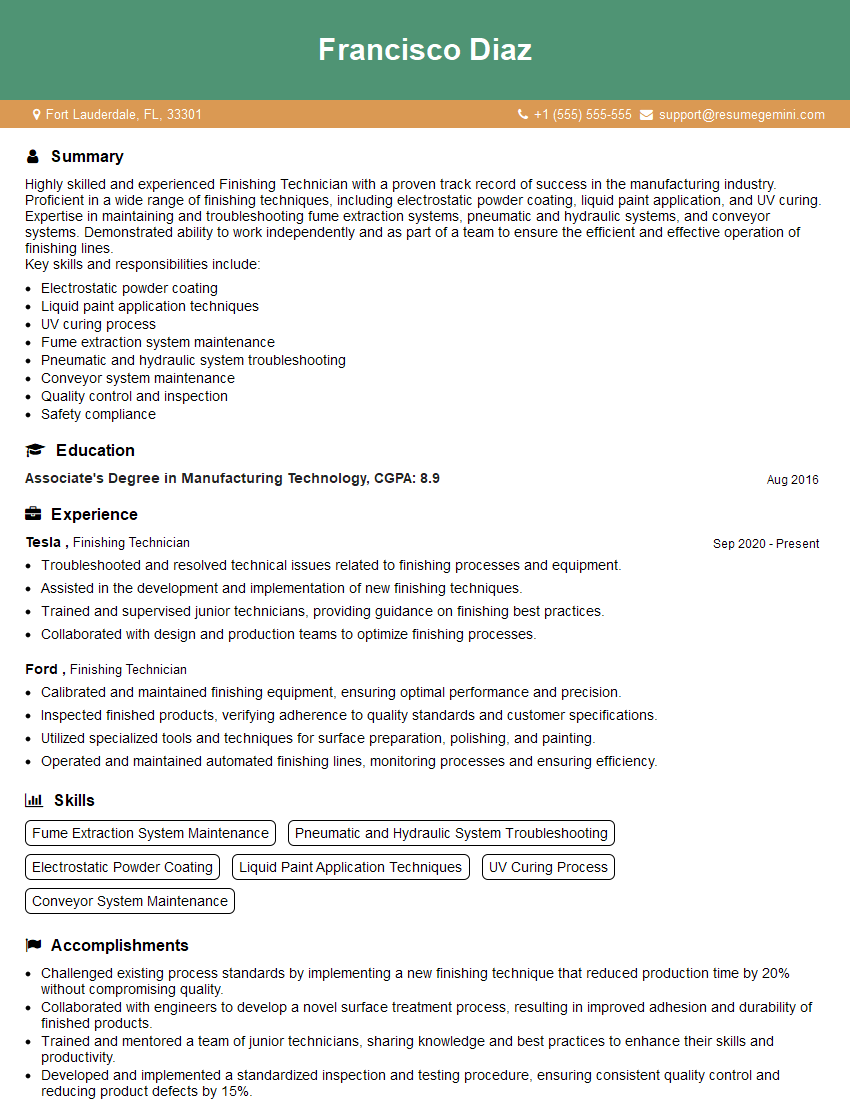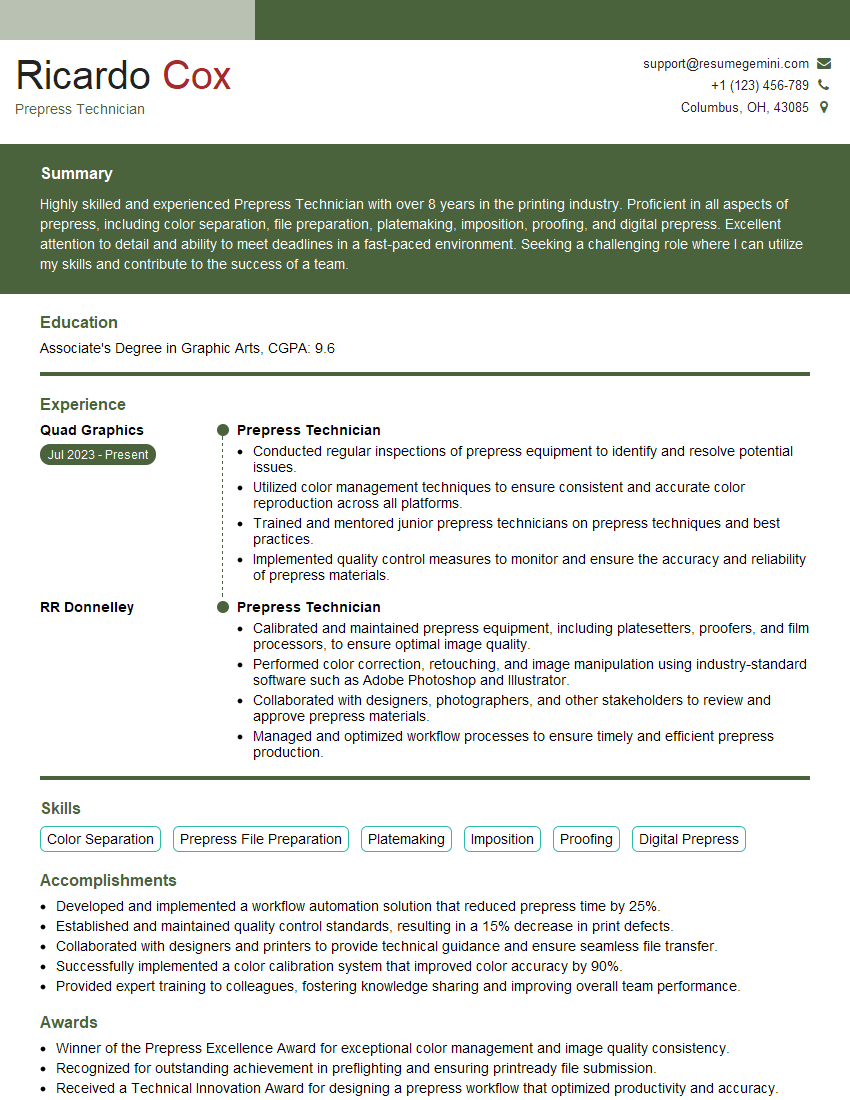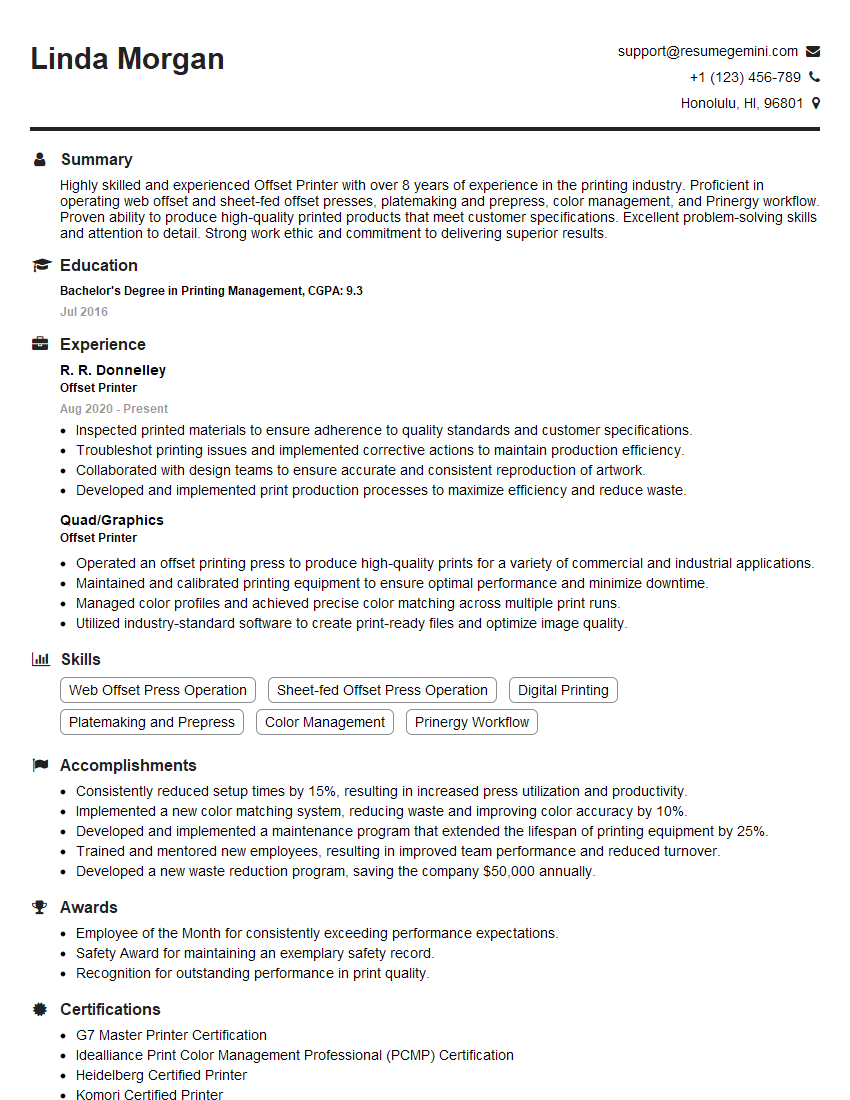Preparation is the key to success in any interview. In this post, we’ll explore crucial Packaging and Finishing Processes interview questions and equip you with strategies to craft impactful answers. Whether you’re a beginner or a pro, these tips will elevate your preparation.
Questions Asked in Packaging and Finishing Processes Interview
Q 1. Explain the difference between flexographic and offset printing.
Flexographic and offset printing are both common printing methods for packaging, but they differ significantly in their printing processes. Think of it like this: flexo is like using a rubber stamp, while offset is like using a very precise stencil.
Flexographic printing uses flexible, raised rubber plates to transfer ink onto a substrate. It’s great for printing on flexible materials like films and pouches because the plates can conform to the surface. The ink is applied directly to the plate and then transferred to the substrate. It’s a relatively low-cost process, ideal for high-volume printing, and known for its versatility in substrate selection.
Offset printing, on the other hand, uses a flat printing plate to transfer ink onto a rubber blanket, which then transfers it to the substrate. This indirect transfer results in sharper, more detailed images, especially with fine lines and text, than flexography. It’s often preferred for high-quality, detailed printing on more rigid materials like cardboard and paperboard. However, it’s typically more expensive and less adaptable to different substrates than flexography.
- Flexography: Simple, cost-effective, high-speed, ideal for flexible substrates, less detail.
- Offset Printing: Higher print quality, sharper detail, more complex setup, better for rigid substrates.
For example, a company might use flexography for printing a large batch of plastic bags, while offset printing might be used for creating high-quality brochures or boxes with intricate designs.
Q 2. Describe your experience with various die-cutting techniques.
My experience encompasses various die-cutting techniques, each suited for different applications and material types. Die-cutting involves using a precisely shaped metal die to cut, pierce, or emboss materials. Think of it like using a cookie cutter, but on a much larger, more precise scale.
I’ve worked extensively with flat-bed die-cutting, which is like using a giant cookie cutter on a flat surface. This is common for cutting thicker materials, like corrugated board. Rotary die-cutting, on the other hand, is much faster and ideal for high-volume production. The die is cylindrical and rotates against a moving substrate; imagine a rolling pin with the cookie cutter shape. This method is perfect for thin materials like paper and film.
Furthermore, I’m familiar with creasing, which is used in conjunction with die-cutting to create folds and score lines. This is essential for creating perfectly folded cartons. Embossing, where a raised or recessed image is created, is another process I’ve employed, adding a tactile and aesthetic element to packaging.
The choice of technique depends on the material, the desired accuracy, the production volume, and budget considerations. For instance, a high-volume production of small, simple boxes will likely use rotary die-cutting, while intricate designs on thick cardboard might necessitate flat-bed die-cutting.
Q 3. What are the common quality control checks for folded cartons?
Quality control for folded cartons is crucial for ensuring product protection and brand image. We typically employ a multi-stage process involving both visual and mechanical checks.
- Visual Inspection: This involves checking for print defects like misregistration, smudging, and color inconsistencies. We also look for flaws in the folding, such as creases in the wrong place or misaligned panels. We often use light boxes to detect inconsistencies in print density.
- Dimensional Checks: Precise measurements of the carton’s length, width, and depth are carried out to ensure conformity to the specifications. Any deviation can affect the product’s fit and stability.
- Bursting Strength Test: This measures the carton’s ability to withstand internal pressure. It’s critical for ensuring the carton can handle the weight of the product and the stresses of shipping.
- Edge Crush Test (ECT): This test determines the resistance of the carton’s board to compression. This is particularly important for protecting the product during transit.
- Random Sampling: A statistical sampling approach is employed to inspect a subset of the cartons produced, providing a representative sample of overall quality.
Any discrepancies identified lead to corrective actions, including adjustments to the machinery or re-processing of defective cartons. Detailed records are maintained to track and improve the quality control process.
Q 4. How do you ensure color consistency in packaging printing?
Maintaining color consistency in packaging printing is paramount for brand recognition and visual appeal. Inconsistent colors can damage brand reputation and even cause legal issues.
We utilize several methods:
- Color Management System (CMS): A CMS helps to ensure consistent color reproduction across different printing processes and substrates. This involves careful calibration of all equipment, such as the printing press, scanning devices, and monitors.
- Color Standards: We use standardized color systems, such as Pantone or GMG, to ensure that the desired colors are consistently achieved. Pantone color swatches are physically checked against the printed output.
- Proofing: Before starting a large print run, we always create color proofs. These proofs are carefully compared against the approved artwork to ensure that the colors are accurate. Different types of proofing, such as digital proofs or hard copy proofs, are chosen depending on the complexity and importance of the job.
- Regular Calibration: Regular calibration of the printing equipment is vital. This minimizes variation in the ink delivery and printing pressure. Regular checks of the ink itself and careful control of the printing environment (temperature, humidity) are crucial.
- Spot Color vs. Process Color: For critical colors, we might use spot colors (specific ink formulations) rather than process colors (CMYK), which offers more control over achieving the exact required shade.
By implementing these strategies, we minimize color deviations, resulting in consistent and high-quality packaging.
Q 5. Explain the importance of substrate selection in packaging.
Substrate selection is critical in packaging design; it’s the foundation upon which the entire package is built. The right substrate affects everything from print quality and protection to cost and sustainability.
Factors to consider include:
- Product Compatibility: The substrate must protect the product from damage, spoilage, or contamination. For example, a food item requiring refrigeration would necessitate a substrate with good barrier properties, while a fragile item might need a more cushioning material.
- Printability: The chosen substrate must be compatible with the chosen printing method. Some materials are better suited for flexography while others work better with offset printing.
- Cost: Different substrates have different price points, impacting the overall cost of the packaging.
- Sustainability: Environmental impact is a major concern. Companies are increasingly prioritizing eco-friendly options.
- Shelf Appeal: The substrate’s texture, color, and overall look influence how consumers perceive the product.
For example, a premium chocolate bar might use a high-quality paperboard with a foil lamination, while a basic cereal might use a less expensive corrugated cardboard box. The choice of substrate is a strategic decision that takes all these factors into account.
Q 6. What are some sustainable packaging materials and their applications?
The push towards sustainable packaging is driving innovation in materials. Several options are emerging:
- Recycled Paperboard: Widely used and readily recyclable, recycled paperboard offers a sustainable alternative to virgin materials. Its printability and strength are well-established and suitable for many packaging types, from food cartons to boxes.
- Bioplastics: Derived from renewable resources like corn starch or sugarcane, bioplastics offer a biodegradable option. However, not all bioplastics are compostable, and their properties need careful consideration regarding barrier and strength properties.
- Bagasse: A byproduct of sugarcane processing, bagasse is used to create pulp that can be molded into packaging containers, offering a compostable solution with low environmental impact.
- Mushroom Packaging: Grown from agricultural waste, this unique packaging is completely compostable and biodegradable, providing a sustainable choice with unusual aesthetic qualities.
- PLA (Polylactic Acid): A biodegradable plastic made from renewable resources. It’s often used for films and other flexible packaging. However, it has limitations in its barrier properties and heat resistance.
The application of these materials depends on several factors, including the product’s nature, shelf life requirements, and end-of-life disposal methods. Each material has its advantages and limitations, and selection requires careful consideration.
Q 7. Describe your experience with different types of laminating processes.
Laminating enhances the functionality and appearance of packaging. It combines different materials to create a composite structure with desired properties. I have experience with several types:
- Dry Lamination: This technique uses adhesive layers that are activated by heat and pressure. It’s fast and efficient, ideal for large-scale production, and commonly used for high-volume packaging like flexible films. The layers are fused together under heat and pressure, resulting in a strong bond.
- Wet Lamination: This involves applying an adhesive to one substrate, allowing it to dry partially, and then bonding it to another substrate under pressure. It allows for more control over the adhesive application but is a slower process than dry lamination.
- Extrusion Lamination: This involves applying a molten adhesive layer between substrates using an extrusion head. This method is efficient for creating high-barrier packaging because it allows for thinner adhesive layers resulting in better flexibility.
- Solvent-Based Lamination: Using solvents to activate the adhesive, this process offers strong bonds and excellent adhesion to different materials. However, it’s being phased out due to environmental concerns regarding volatile organic compounds (VOCs).
The choice of laminating process depends on the required properties of the final package, the nature of the substrates being combined, and the desired production speed and cost. For example, a high-barrier packaging for food products might require extrusion lamination, while a simple paper-based box might be laminated using a dry lamination process.
Q 8. How do you troubleshoot common issues in a packaging production line?
Troubleshooting a packaging production line requires a systematic approach. Think of it like diagnosing a car problem – you need to identify the symptoms, isolate the cause, and then implement the fix. I start by observing the line for any obvious issues: Is there a jam? Are machines running at the correct speed? Are there any unusual noises or smells? Then, I’d consult machine logs and operator notes to pinpoint when the problem began and what might have preceded it.
For example, if we’re experiencing frequent jams in a carton erecting machine, I’d first check the carton blanks for proper dimensions and quality. Are they damaged? Are they correctly scored and folded? Next, I would examine the machine’s settings: is the glue application correct? Are the belts and rollers properly aligned? Sometimes, the simplest solution is a quick adjustment; other times, it may involve replacing a worn part or calling in a specialist.
My approach involves a combination of visual inspection, data analysis, and a thorough understanding of the individual machines and their interdependencies within the overall production process. A multi-step checklist helps ensure no element is overlooked.
Q 9. Explain the role of prepress in the packaging process.
Prepress in packaging is the crucial bridge between design and production. It’s where the packaging artwork is finalized and prepared for printing. Think of it as the blueprint for the final product. This stage involves several key steps:
- Artwork preparation: This includes ensuring the artwork is in the correct format (e.g., high-resolution PDF), color space (usually CMYK), and resolution for optimal print quality. We correct any inconsistencies and ensure all design elements are correctly positioned.
- Color separation: This is especially important for multi-color printing. Each color is separated into its own plate (or file for digital printing) ensuring accurate reproduction.
- Platemaking: For traditional printing, this involves creating printing plates from the prepared artwork. These are then mounted onto the printing press.
- Proofing: This involves creating physical or digital proofs to approve color accuracy, design placement, and overall quality before committing to a large print run. This step is crucial for catching errors early and preventing costly mistakes.
Errors in prepress can lead to significant issues down the line, such as misaligned printing, inaccurate colors, and even wasted materials. Therefore, meticulous attention to detail is critical in this phase.
Q 10. What are the key considerations for designing packaging for e-commerce?
E-commerce packaging presents unique challenges. It needs to protect the product during shipping, be visually appealing to the customer, and be cost-effective. Key considerations include:
- Product protection: The packaging must withstand the rigors of shipping, including stacking, dropping, and vibration. This often necessitates the use of cushioning materials, such as bubble wrap or void fill.
- Sustainability: Consumers are increasingly environmentally conscious. Using recycled materials, reducing packaging size, and selecting easily recyclable materials are vital.
- Branding and unboxing experience: The packaging should reflect the brand’s identity and create a positive unboxing experience for the customer. A well-designed package can enhance brand perception and create customer loyalty.
- Shipping costs and dimensions: Smaller packages reduce shipping costs. Optimizing the dimensions to minimize wasted space is crucial for cost savings and sustainability.
- Print quality: High-quality printing enhances brand image and communicates vital information clearly.
For example, a company selling fragile electronics would prioritize robust cushioning and impact-resistant packaging, while a company selling apparel might focus on sustainable materials and a visually attractive presentation.
Q 11. How do you manage inventory and ensure efficient material flow in a packaging facility?
Efficient inventory and material flow are essential for smooth packaging production. I use a combination of strategies:
- Inventory management system: We use a computerized system to track inventory levels in real-time, enabling us to anticipate shortages and avoid overstocking. This usually involves using barcodes or RFID tags to track materials.
- Just-in-time (JIT) inventory: We strive to receive materials only when needed to minimize storage costs and reduce waste. This requires close collaboration with suppliers.
- Optimized warehouse layout: The layout of our warehouse is designed to minimize movement of materials and maximize efficiency. Frequently used materials are easily accessible.
- Kanban system: This visual system signals when more materials are needed, providing an effective means of managing replenishment.
- Regular inventory audits: Regular physical counts help maintain accuracy in inventory records.
By implementing these strategies, we ensure that the right materials are available at the right time, preventing production delays and minimizing waste.
Q 12. Describe your experience with different types of adhesives used in packaging.
My experience spans several types of adhesives, each with its own advantages and disadvantages:
- Hot melt adhesives: These are widely used for their fast setting time and ease of application. They’re excellent for carton sealing and various other applications but require specialized equipment.
- Water-based adhesives: These are more environmentally friendly than solvent-based options and are often used in label applications and for gluing paperboard. However, they have longer drying times.
- Pressure-sensitive adhesives (PSA): These are found in labels and tapes; they’re convenient and easy to use but can be less robust for heavy-duty applications.
- Solvent-based adhesives: These offer strong bonds but often involve VOCs (volatile organic compounds), raising environmental concerns. They are sometimes used for very high-strength bonding applications.
The choice of adhesive depends on several factors, including the materials being bonded, the required bond strength, the production speed, and environmental considerations. I always consider the complete lifecycle implications of the adhesive.
Q 13. How do you ensure packaging meets regulatory compliance requirements (e.g., FDA)?
Ensuring packaging meets regulatory compliance is paramount, especially for food and pharmaceutical products. This involves several key steps:
- Material selection: We must use materials that meet the specific requirements of the regulatory body (e.g., FDA-approved materials for food contact). We maintain detailed records of all materials used.
- Labeling accuracy: Labels must accurately reflect the product contents, nutritional information (where applicable), and any necessary warnings. We have a strict process for label review and approval.
- Testing and certification: We regularly conduct tests to ensure our packaging meets the required standards for safety, migration limits, and other relevant parameters. This may involve third-party testing and certification to provide verifiable compliance evidence.
- Documentation: We meticulously maintain all relevant documentation related to materials, testing, and compliance, allowing for easy traceability and auditing.
Non-compliance can lead to product recalls, fines, and damage to brand reputation, so this is a highly critical area.
Q 14. What are some common challenges in managing packaging waste?
Managing packaging waste is a significant challenge across the industry. Some common problems include:
- Waste generation: Packaging often generates a substantial amount of waste, particularly in high-volume operations. This needs to be carefully managed.
- Recycling complexities: Many packaging materials are difficult or impossible to recycle due to their composition or lack of suitable recycling infrastructure. This includes multi-material laminates.
- Disposal costs: Landfill disposal fees and waste management costs can be substantial, especially for large volumes of non-recyclable waste.
- Sustainability concerns: The environmental impact of packaging waste is a growing concern for consumers and regulators. This necessitates a focus on sustainable packaging options.
We address these challenges through strategies like waste reduction initiatives, increased use of recyclable materials, partnerships with recycling companies, and exploration of innovative, compostable, or biodegradable packaging alternatives.
Q 15. Explain your understanding of different types of printing inks and their properties.
Printing inks are the lifeblood of packaging, dictating color, vibrancy, and even the tactile experience. There’s a vast array, each with its own unique properties. We broadly categorize them based on their chemical composition and drying mechanism.
- Solvent-based inks: These are traditionally used and offer vibrant colors with excellent adhesion. However, they have volatile organic compounds (VOCs) that need careful management due to environmental concerns. Think of the rich, bold colors on many luxury product boxes.
- Water-based inks: Environmentally friendlier than solvent-based, these inks use water as the solvent. They’re often preferred for food packaging due to lower VOCs. The colors may be slightly less vibrant, but advancements are continuously bridging this gap.
- UV (Ultraviolet) curable inks: These inks cure instantly upon exposure to UV light. This is incredibly fast, allowing for high-speed printing and immediate further processing. Think of the glossy labels on cosmetics or pharmaceuticals; many use UV inks.
- EB (Electron Beam) curable inks: Similar to UV curing, but uses electron beams for curing. This offers even faster curing speeds and deeper penetration into substrates.
- Vegetable-based inks: These are increasingly popular due to their sustainability credentials. Made from renewable resources, they are often chosen for environmentally conscious brands. Their color range might be more limited, but this is constantly evolving.
Selecting the right ink depends on factors like the substrate (material being printed on), the required print quality, printing method, speed, and environmental regulations. For example, a food package would require food-grade inks with low migration properties to prevent contamination.
Career Expert Tips:
- Ace those interviews! Prepare effectively by reviewing the Top 50 Most Common Interview Questions on ResumeGemini.
- Navigate your job search with confidence! Explore a wide range of Career Tips on ResumeGemini. Learn about common challenges and recommendations to overcome them.
- Craft the perfect resume! Master the Art of Resume Writing with ResumeGemini’s guide. Showcase your unique qualifications and achievements effectively.
- Don’t miss out on holiday savings! Build your dream resume with ResumeGemini’s ATS optimized templates.
Q 16. How do you measure and control the quality of printed packaging?
Quality control in printed packaging is crucial. It involves a multi-step process, starting even before printing with verifying the artwork and print files for accuracy. During printing, we constantly monitor:
- Color accuracy: Using densitometers and spectrophotometers, we measure the color density and compare it to the standards. Think of it like ensuring your recipe follows the exact measurements.
- Register: This refers to how accurately different colors align. We use a microscope or other inspection tools to ensure perfect alignment of multi-colored designs – like aligning puzzle pieces.
- Dot gain: This is the increase in the size of printed dots during the printing process. Too much dot gain leads to muddy colors; too little, to poor image quality. We use sophisticated measuring instruments to control this.
- Print defects: We visually inspect the printed sheets for any flaws like smudging, scratches, or missing ink. This often includes automated inspection systems for large print runs.
After printing, we perform further checks on the finished package, including dimensional accuracy, structural integrity, and seal integrity if it’s a sealed package. Data is recorded and analyzed for continuous improvement. This ensures we meet the high standards our clients expect and comply with industry regulations.
Q 17. Describe your experience with automated packaging machinery.
My experience encompasses a range of automated packaging machinery, from simpler machines like case packers and label applicators to more complex systems involving integrated robotic arms and automated palletizers. I’m familiar with PLC (Programmable Logic Controller) programming and troubleshooting, essential for keeping these systems running smoothly.
For example, I worked on a project integrating a high-speed cartoning machine with a robotic palletizer. The challenge was optimizing the throughput while ensuring the cartons were handled without damage. We implemented a vision system to verify carton integrity before palletizing and adjusted the robot’s movements to minimize jarring. The result was a significant increase in productivity and reduced product damage.
I also possess hands-on experience with various types of filling machines, including volumetric fillers, net weight fillers, and liquid fillers. Understanding the intricacies of these machines is critical to ensuring efficient and consistent product packaging.
Q 18. How do you handle customer complaints related to packaging defects?
Handling customer complaints regarding packaging defects involves a systematic approach. The first step is to listen carefully to the customer and understand the nature of the complaint. Next, we gather all relevant information, including photos or videos of the defective packaging and batch numbers. This allows us to trace the origin of the problem.
Then, we conduct a thorough internal investigation, examining the production process, machinery logs, and material quality records. This helps pinpoint the root cause. Once the root cause is identified, we take corrective actions to prevent similar issues from occurring in the future. This might involve adjusting machine settings, improving quality control procedures, or replacing faulty equipment.
Finally, we communicate our findings and the corrective actions taken to the customer. We aim for a resolution that satisfies the customer, offering solutions like replacements or refunds, as appropriate. Transparency and a focus on resolving the issue effectively are paramount.
Q 19. Explain your experience with different types of folding carton constructions.
Folding carton constructions vary widely, each tailored for specific product needs and branding objectives. My experience spans various types, including:
- Straight tuck style: The simplest, with four panels that tuck in to form a box. Ideal for basic packaging needs.
- Reverse tuck style: Panels fold inward, offering a more rigid structure.
- Auto bottom style: The bottom panels automatically lock into place during formation, ideal for high-speed automated packaging lines.
- Lock bottom style: Offers superior strength and rigidity; great for heavier products.
- Booklet style: Similar to a book; panels fold inward to create a booklet-like structure often used for leaflets and inserts.
Beyond the basic styles, intricate designs incorporate features like glued flaps, specialized locking mechanisms, and window cutouts to create unique and appealing packaging. Understanding the strengths and limitations of each style is essential for making informed decisions based on product characteristics and desired aesthetic.
Q 20. What software or tools are you familiar with for packaging design and production?
My software proficiency includes Adobe Creative Suite (Illustrator, Photoshop, InDesign) for packaging design and prepress preparation. I’m also adept at using 3D modeling software like SolidWorks and AutoCAD for creating detailed structural designs and virtual prototypes.
In production, I’m familiar with various prepress software programs for managing color profiles, creating imposition schemes (arranging pages for efficient printing), and generating cutting dies. I’m also experienced with MIS (Manufacturing Information Systems) software for managing production data, tracking inventory, and monitoring KPIs (Key Performance Indicators).
Furthermore, I have worked with specialized software for creating augmented reality (AR) experiences integrated into packaging designs, which adds a modern interactive element to product presentation.
Q 21. How do you optimize packaging design for cost-effectiveness?
Optimizing packaging design for cost-effectiveness requires a holistic approach, balancing aesthetics with functionality and material usage. Key strategies include:
- Right-sizing the packaging: Avoid excessive packaging materials. Using the minimum amount of material necessary to protect the product effectively reduces material costs. Think of it like finding the perfectly sized suitcase for your trip—not too big, not too small.
- Material selection: Choosing cost-effective yet appropriate materials is vital. Recycled materials or sustainable alternatives can also reduce costs while enhancing the brand image. Consider the product’s fragility and environmental considerations.
- Design simplification: Reducing the complexity of the design reduces production time and costs. Simple, clean designs often translate into more efficient and less expensive manufacturing processes.
- Efficient die-cutting and printing designs: Optimizing the layout of the die-cut pattern minimizes waste and maximizes the utilization of material on the printing sheet. This is like arranging jigsaw puzzle pieces to minimize gaps.
- Collaboration with suppliers: Building strong relationships with suppliers and negotiating favorable pricing on materials and printing services can significantly impact overall costs.
Through careful consideration of these factors and continual evaluation of the packaging design, significant cost savings can be achieved without compromising product protection or brand appeal.
Q 22. What are your strategies for improving efficiency in packaging operations?
Improving efficiency in packaging operations requires a multifaceted approach focusing on optimizing processes, technology, and workforce management. Think of it like orchestrating a symphony – every instrument (process) needs to play in harmony for a beautiful result (efficient packaging).
Process Optimization: This involves analyzing the entire packaging workflow, identifying bottlenecks (areas causing delays), and streamlining operations. For example, we might implement a just-in-time (JIT) inventory system to reduce warehousing costs and minimize material handling. Another strategy involves mapping the entire process and finding ways to eliminate unnecessary steps. In one project, we reduced the number of steps in our secondary packaging process by 15%, resulting in a significant increase in throughput.
Technology Integration: Automating processes wherever feasible is key. This could involve implementing robotic palletizers for faster and more consistent palletizing or using automated labeling machines to reduce manual labor and improve accuracy. For instance, integrating a barcode scanning system at the beginning of the packaging line allowed us to track individual units, improving inventory management and reducing errors significantly.
Workforce Empowerment: Training employees on efficient work methods, lean principles, and proper equipment operation is crucial. Empowering employees to identify and suggest improvements can foster a culture of continuous improvement. We once implemented a suggestion box system where employees could propose improvements, and several of their ideas resulted in remarkable efficiency gains.
Data Analysis: Utilizing data analytics to track key performance indicators (KPIs) like packaging speed, waste, and downtime allows for continuous monitoring and improvement. Identifying trends and patterns in data helps us predict and prevent problems before they occur.
Q 23. Explain your experience with lean manufacturing principles in a packaging environment.
Lean manufacturing principles, focusing on eliminating waste and maximizing efficiency, are integral to my approach to packaging. Think of it as ‘doing more with less’ – improving output while minimizing resource consumption.
Value Stream Mapping: I’ve extensively used value stream mapping to visually represent the entire packaging process, identifying areas where value is added versus where waste occurs (e.g., excess inventory, unnecessary movement, defects). This allowed us to pinpoint bottlenecks and implement targeted improvements.
5S Methodology: Implementing 5S (Sort, Set in Order, Shine, Standardize, Sustain) in our packaging facilities created a more organized and efficient workspace. This reduced wasted time searching for materials and improved overall safety.
Kaizen Events: Participating in Kaizen events, focused improvement projects involving cross-functional teams, allowed us to tackle specific challenges systematically. For example, a Kaizen event focused on improving the efficiency of our case erecting machine resulted in a 10% increase in production speed.
These lean principles, applied strategically, have consistently led to reduced costs, improved quality, and faster lead times in packaging projects I’ve overseen.
Q 24. Describe your experience with different types of coatings used in packaging.
My experience encompasses a wide range of coatings used in packaging, each with its own properties and applications. Choosing the right coating is crucial for achieving desired functionality and aesthetics.
Water-based coatings: Environmentally friendly, these are often used for their low VOC (Volatile Organic Compound) emissions. They offer good printability and adhesion but might require longer drying times compared to other options.
UV (Ultraviolet) coatings: These cure instantly upon exposure to UV light, leading to faster production speeds. They offer excellent scratch resistance and gloss, commonly used for high-end packaging.
Solvent-based coatings: Offering superior gloss and durability, these are often preferred for demanding applications, but their high VOC emissions present environmental concerns.
Lacquers: These are fast-drying, versatile coatings used to enhance the appearance and protection of packaging. They come in various gloss levels and can provide additional barrier properties.
The choice of coating depends heavily on the packaging material, the product being packaged, and the desired properties (e.g., scratch resistance, printability, barrier properties, environmental impact).
Q 25. How do you stay up-to-date with the latest trends in packaging technology?
Staying current with packaging technology trends is vital. My strategies include:
Industry Publications and Trade Shows: I regularly read publications like Packaging World and attend industry events such as PACK EXPO to learn about the latest innovations and interact with leading companies.
Online Resources and Webinars: Online platforms and webinars offer valuable insights into emerging technologies and best practices. I actively participate in online communities and forums related to packaging.
Networking with Professionals: Engaging with peers and experts through professional organizations and conferences expands my knowledge and provides diverse perspectives.
Supplier Relationships: Maintaining close contact with material suppliers and equipment manufacturers keeps me informed about new product developments and technological advancements.
This multi-pronged approach ensures I am always aware of the latest advancements and can effectively incorporate them into my projects.
Q 26. What are some of the challenges you anticipate in the future of packaging?
The future of packaging presents several key challenges:
Sustainability: The growing demand for eco-friendly packaging necessitates the development of biodegradable, compostable, and recyclable materials. Balancing cost-effectiveness with environmental responsibility is a major hurdle.
E-commerce Growth: The rise of e-commerce demands packaging solutions optimized for automated handling, protection during transit, and reduced dimensional weight.
Supply Chain Disruptions: Resilience in the face of supply chain volatility is essential. We need to develop strategies to ensure the consistent availability of materials and efficient logistics.
Consumer Expectations: Consumers are increasingly demanding aesthetically pleasing and functional packaging, placing greater emphasis on brand experience and product information.
Regulations and Compliance: Navigating the evolving regulatory landscape, including food safety and labeling standards, is a continuous challenge.
Addressing these challenges requires innovation, collaboration across the supply chain, and a commitment to sustainable and responsible packaging practices.
Q 27. Explain your experience with different types of packaging materials (e.g., paperboard, plastic, metal).
My experience spans a wide range of packaging materials, each with its own strengths and limitations:
Paperboard: A versatile material offering good printability, recyclability, and cost-effectiveness. It’s suitable for various applications, from cartons to folding boxes. However, its susceptibility to moisture and its lower barrier properties limit its use for certain products.
Plastics: Offering excellent barrier properties, durability, and formability, plastics are widely used for various applications, including films, bottles, and tubs. However, their environmental impact and recyclability concerns are increasingly important considerations.
Metals (Aluminum, Steel): These provide superior barrier protection, durability, and recyclability. They are ideal for products requiring extended shelf life or protection from external factors. However, their cost and weight can be limitations.
Material selection is a crucial aspect of packaging design, demanding careful consideration of product characteristics, environmental impact, and cost-effectiveness.
Key Topics to Learn for Packaging and Finishing Processes Interview
- Packaging Materials & Selection: Understanding different materials (paperboard, corrugated board, plastics, films) and their properties, suitability for various products, and environmental impact. Consider factors like cost, durability, and printability.
- Printing Techniques: Familiarity with flexographic, offset, gravure, and digital printing methods; their applications, advantages, and limitations. Be prepared to discuss color management and print quality control.
- Converting Processes: Knowledge of die-cutting, creasing, scoring, folding, gluing, and laminating. Understand the machinery involved and how these processes impact final package aesthetics and functionality.
- Finishing Operations: Explore various finishing techniques like embossing, debossing, varnishing, coating, and hot-foil stamping. Discuss their purpose in enhancing product appeal and protection.
- Automation & Packaging Lines: Understand the integration of different machinery within packaging lines, including high-speed automation and quality control systems. Discuss troubleshooting and optimization strategies.
- Packaging Design & Engineering: Discuss the principles of effective package design, considering factors like ergonomics, sustainability, and consumer appeal. Be prepared to discuss structural design and its influence on functionality.
- Quality Control & Assurance: Understand quality control methodologies within packaging and finishing processes, including statistical process control (SPC) and quality inspection techniques. Discuss the importance of meeting industry standards and regulations.
- Sustainability and Environmental Considerations: Discuss the growing importance of sustainable packaging materials and processes, including recycling, compostability, and reduced environmental footprint.
- Problem-Solving & Troubleshooting: Be ready to discuss your approach to solving problems related to packaging line inefficiencies, material defects, and quality issues. Highlight your analytical and critical thinking skills.
Next Steps
Mastering Packaging and Finishing Processes is crucial for career advancement in this dynamic industry. A strong understanding of these processes will open doors to exciting opportunities and higher responsibilities. To maximize your job prospects, create an ATS-friendly resume that effectively showcases your skills and experience. We strongly recommend using ResumeGemini to build a professional and impactful resume. ResumeGemini provides tools and resources to help you create a resume that stands out, and we offer examples of resumes tailored to Packaging and Finishing Processes to help guide you.
Explore more articles
Users Rating of Our Blogs
Share Your Experience
We value your feedback! Please rate our content and share your thoughts (optional).
What Readers Say About Our Blog
Hello,
We found issues with your domain’s email setup that may be sending your messages to spam or blocking them completely. InboxShield Mini shows you how to fix it in minutes — no tech skills required.
Scan your domain now for details: https://inboxshield-mini.com/
— Adam @ InboxShield Mini
Reply STOP to unsubscribe
Hi, are you owner of interviewgemini.com? What if I told you I could help you find extra time in your schedule, reconnect with leads you didn’t even realize you missed, and bring in more “I want to work with you” conversations, without increasing your ad spend or hiring a full-time employee?
All with a flexible, budget-friendly service that could easily pay for itself. Sounds good?
Would it be nice to jump on a quick 10-minute call so I can show you exactly how we make this work?
Best,
Hapei
Marketing Director
Hey, I know you’re the owner of interviewgemini.com. I’ll be quick.
Fundraising for your business is tough and time-consuming. We make it easier by guaranteeing two private investor meetings each month, for six months. No demos, no pitch events – just direct introductions to active investors matched to your startup.
If youR17;re raising, this could help you build real momentum. Want me to send more info?
Hi, I represent an SEO company that specialises in getting you AI citations and higher rankings on Google. I’d like to offer you a 100% free SEO audit for your website. Would you be interested?
Hi, I represent an SEO company that specialises in getting you AI citations and higher rankings on Google. I’d like to offer you a 100% free SEO audit for your website. Would you be interested?
good
